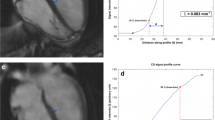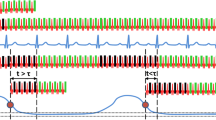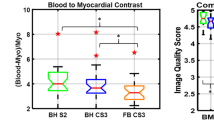Abstract
This study aimed to assess the image quality and accuracy of respiratory-gated real-time two-dimensional (2D) cine incorporating deep learning reconstruction (DLR) for the quantification of biventricular volumes and function compared with those of the standard reference, that is, breath-hold 2D balanced steady-state free precession (bSSFP) cine, in an adult population. Twenty-four patients (15 men, mean age 50.7 ± 16.5 years) underwent cardiac magnetic resonance for clinical indications, and 2D DLR and bSSFP cine were acquired on the short-axis view. The image quality scores were based on three main criteria: blood-to-myocardial contrast, endocardial edge delineation, and presence of motion artifacts throughout the cardiac cycle. Biventricular end-diastolic volume (EDV), end-systolic volume (ESV), stroke volume (SV), ejection fraction (EF), and left ventricular mass (LVM) were analyzed. The 2D DLR cine had significantly shorter scan time than bSSFP (41.0 ± 11.3 s vs. 327.6 ± 65.8 s; p < 0.0001). Despite an analysis of endocardial edge definition and motion artifacts showed significant impairment using DLR cine compared with bSSFP (p < 0.01), the two sequences demonstrated no significant difference in terms of biventricular EDV, ESV, SV, and EF (p > 0.05). Moreover, the linear regression yielded good agreement between the two techniques (r ≥ 0.76). However, the LVM was underestimated for DLR cine (109.8 ± 34.6 g) compared with that for bSSFP (116.2 ± 40.2 g; p = 0.0291). Respiratory-gated 2D DLR cine is a reliable technique that could be used in the evaluation of biventricular volumes and function in an adult population.






Similar content being viewed by others
Data availability
The dataset analyzed during the present study is available from the corresponding author on reasonable request.
Abbreviations
- 2D:
-
two-dimensional
- bSSFP:
-
balanced steady-state free precession
- DLR:
-
deep learning reconstruction
- CMR:
-
cardiac magnetic resonance
- LVEDV:
-
left ventricular (LV) end-diastolic volume
- LVESV:
-
LV end-systolic volume
- LVSV:
-
LV stroke volume
- LVEF:
-
LV ejection fraction
- LVM:
-
LV mass
- RVEDV:
-
right ventricular (RV) end-diastolic volume
- RVESV:
-
RV end-systolic volume
- RVSV:
-
RV stroke volume
- RVEF:
-
RV ejection fraction
- SD:
-
standard deviation
- ICC:
-
intraclass correlation coefficients
- CI:
-
confidence interval
- CHD:
-
congenital heart disease
References
Carr JC, Simonetti O, Bundy J, Li D, Pereles S, Finn JP (2001) Cine MR angiography of the heart with segmented true fast imaging with steady-state precession. Radiology 219:828–834. https://doi.org/10.1148/radiology.219.3.r01jn44828
Varga-Szemes A, Muscogiuri G, Schoepf UJ, Wichmann JL, Suranyi P, De Cecco CN, Cannaò PM, Renker M, Mangold S, Fox MA, Ruzsics B (2016) Clinical feasibility of a myocardial signal intensity threshold-based semi-automated cardiac magnetic resonance segmentation method. Eur Radiol 26:1503–1511. https://doi.org/10.1007/s00330-015-3952-4
Goebel J, Nensa F, Schemuth HP, Maderwald S, Gratz M, Quick HH, Schlosser T, Nassenstein K (2016) Compressed sensing cine imaging with high spatial or high temporal resolution for analysis of left ventricular function. J Magn Reson Imaging 44:366–374. https://doi.org/10.1002/jmri.25162
Camargo GC, Erthal F, Sabioni L, Penna F, Strecker R, Schmidt M, Zenge MO, Lima RS, Gottlieb I (2017) Real-time cardiac magnetic resonance cine imaging with sparse sampling and iterative reconstruction for left-ventricular measures: comparison with gold-standard segmented steady-state free precession. Magn Reson Imaging 38:138–144. https://doi.org/10.1016/j.mri.2017.01.002
Atweh LA, Dodd NA, Krishnamurthy R, Pednekar A, Chu ZD, Krishnamurthy R (2016) Comparison of two single-breath-held 3-D acquisitions with multi-breath-held 2-D cine steady-state free precession MRI acquisition in children with single ventricles. Pediatr Radiol 46:637–645. https://doi.org/10.1007/s00247-015-3531-5
Krishnamurthy R, Pednekar A, Atweh LA, Vogelius E, Chu ZD, Zhang W, Maskatia S, Masand P, Morris SA, Krishnamurthy R, Muthupillai R (2015) Clinical validation of free breathing respiratory triggered retrospectively cardiac gated cine balanced steady-state free precession cardiovascular magnetic resonance in sedated children. J Cardiovasc Magn Reson 17:1. https://doi.org/10.1186/s12968-014-0101-1
Orii M, Sugawara T, Takagi H, Nakano S, Ueda H, Takizawa Y, Fujiwara J, Takahashi S, Oyama K, Lai P, Janich MA, Nozaki A, Yoshioka K (2021) Reliability of respiratory-triggered two-dimensional cine k-adaptive-t-autocalibrating reconstruction for cartesian sampling for the assessment of biventricular volume and function in patients with repaired tetralogy of Fallot. Br J Radiol 94:20201249. https://doi.org/10.1259/bjr.20201249
Pednekar AS, Wang H, Flamm S, Cheong BY, Muthupillai R (2018) Two center clinical validation and quantitative assessment of respiratory triggered retrospectively cardiac gated balanced-SSFP cine cardiovascular magnetic resonance imaging in adults. J Cardiovasc Magn Reson 20:44. https://doi.org/10.1186/s12968-018-0467-6
Masutani EM, Bahrami N, Hsiao A (2020) Deep learning single-frame and multiframe super-resolution for cardiac MRI. Radiology 295:552–561. https://doi.org/10.1148/radiol.2020192173
Sandino CM, Lai P, Vasanawala SS, Cheng JY (2021) Accelerating cardiac cine MRI using a deep learning-based ESPIRiT reconstruction. Magn Reson Med 85:152–167. https://doi.org/10.1002/mrm.28420
Zucker EJ, Sandino CM, Kino A, Lai P, Vasanawala SS (2021) Free-breathing accelerated cardiac MRI using deep learning: validation in children and young adults. Radiology 300:539–548. https://doi.org/10.1148/radiol.2021202624
Petersen SE, Aung N, Sanghvi MM, Zemrak F, Fung K, Paiva JM, Francis JM, Khanji MY, Lukaschuk E, Lee AM, Carapella V, Kim YJ, Leeson P, Piechnik SK, Neubauer S (2017) Reference ranges for cardiac structure and function using cardiovascular magnetic resonance (CMR) in Caucasians from the UK Biobank population cohort. J Cardiovasc Magn Reson 19:18. https://doi.org/10.1186/s12968-017-0327-9
Kramer CM, Barkhausen J, Bucciarelli-Ducci C, Flamm SD, Kim RJ, Nagel E (2020) Standardized cardiovascular magnetic resonance imaging (CMR) protocols: 2020 update. J Cardiovasc Magn Reson 22:17. https://doi.org/10.1186/s12968-020-00607-1
Jeong D, Schiebler ML, Lai P, Wang K, Vigen KK, François CJ (2015) Single breath hold 3D cardiac cine MRI using kat-ARC: preliminary results at 1.5T. Int. J Cardiovasc Imaging 31:851–857. https://doi.org/10.1007/s10554-015-0615-0
Lin ACW, Strugnell W, Riley R, Schmitt B, Zenge M, Schmidt M, Morris NR, Hamilton-Craig C (2017) Higher resolution cine imaging with compressed sensing for accelerated clinical left ventricular evaluation. J Magn Reson Imaging 45:1693–1699. https://doi.org/10.1002/jmri.25525
Rochitte CE, Azevedo CF, Rosário MA, Siqueira MH, Monsão V, Saranathan M, Foo TK, Kalil Filho R, Cerri GG, Ramires JA (2011) Single-breathhold four-dimensional assessment of left ventricular morphological and functional parameters by magnetic resonance imaging using the VAST technique. Open Cardiovasc Med J 5:90–98. https://doi.org/10.2174/1874192401105010090
Jaroni J, Meier R, Beer A, Herrmann K, Settles M, Rummeny EJ, Huber A (2013) Three-dimensional magnetic resonance imaging using single breath-hold k-t BLAST for assessment of global left ventricular functional parameters. Acad Radiol 20:987–994. https://doi.org/10.1016/j.acra.2013.03.012
Ogawa R, Kido T, Nakamura M, Nozaki A, Lebel RM, Mochizuki T, Kido T (2021) Reconstruction of cardiovascular black-blood T2-weighted image by deep learning algorithm: a comparison with intensity filter. Acta Radiol Open 10:20584601211044779. https://doi.org/10.1177/20584601211044779
Hanneman K, Kino A, Cheng JY, Alley MT, Vasanawala SS (2016) Assessment of the precision and reproducibility of ventricular volume, function, and mass measurements with ferumoxytol-enhanced 4D flow MRI. J Magn Reson Imaging 44:383–392. https://doi.org/10.1002/jmri.25180
Kim JP, Deng J, Robinson JD, Seiberlich N, Rigsby CK (2016) A comparison of real-time radial GRAPPA and standard cine imaging for the evaluation of cardiac function in children and young adults. J Cardiovasc Magn Reson 18:O74. https://doi.org/10.1186/1532-429X-18-S1-O74
Stout KK, Daniels CJ, Aboulhosn JA, Bozkurt B, Broberg CS, Colman JM, Crumb SR, Dearani JA, Fuller S, Gurvitz M, Khairy P, Landzberg MJ, Saidi A, Valente AM, Van Hare GF (2019) 2018 AHA/ACC Guideline for the management of adults with congenital heart disease: executive summary: a report of the American College of Cardiology/American Heart Association Task Force on Clinical Practice Guidelines. Circulation 139:e637–e697. https://doi.org/10.1161/CIR.0000000000000602
Bai W, Sinclair M, Tarroni G, Oktay O, Rajchl M, Vaillant G, Lee AM, Aung N, Lukaschuk E, Sanghvi MM, Zemrak F, Fung K, Paiva JM, Carapella V, Kim YJ, Suzuki H, Kainz B, Matthews PM, Petersen SE, Piechnik SK, Neubauer S, Glocker B, Rueckert D (2018) Automated cardiovascular magnetic resonance image analysis with fully convolutional networks. J Cardiovasc Magn Reson 20:65. https://doi.org/10.1186/s12968-018-0471-x
Kilner PJ, Geva T, Kaemmerer H, Trindade PT, Schwitter J, Webb GD (2010) Recommendations for cardiovascular magnetic resonance in adults with congenital heart disease from the respective working groups of the European Society of Cardiology. Eur Heart J 31:794–805. https://doi.org/10.1093/eurheartj/ehp586
Acknowledgements
The authors would like to thank Enago (www.enago.jp) for the English language review.
Funding
Not applicable.
Author information
Authors and Affiliations
Contributions
MO designed and drafted the manuscript. MO and MS acquired data and assessed CMR. MS and TO supported the statistical analysis. KK, TS, XZ, MJ, and AN provided technical assistance. KY substantially contributed to the manuscript and revised it critically for important intellectual content. All authors approved the submitted version.
Corresponding author
Ethics declarations
Ethics approval and consent to participate
The study was approved by the institution’s human research committee (Iwate Medical University). All methods were carried out in accordance with relevant guidelines and regulations, and informed consent was obtained from all individual participants included in the study.
Consent for publication
Written informed consent for publication was obtained from all participants.
Competing interests
The authors declare that they have no conflict of interest.
Additional information
Publisher’s Note
Springer Nature remains neutral with regard to jurisdictional claims in published maps and institutional affiliations.
Rights and permissions
Springer Nature or its licensor (e.g. a society or other partner) holds exclusive rights to this article under a publishing agreement with the author(s) or other rightsholder(s); author self-archiving of the accepted manuscript version of this article is solely governed by the terms of such publishing agreement and applicable law.
About this article
Cite this article
Orii, M., Sone, M., Osaki, T. et al. Reliability of respiratory-gated real-time two-dimensional cine incorporating deep learning reconstruction for the assessment of ventricular function in an adult population. Int J Cardiovasc Imaging 39, 1001–1011 (2023). https://doi.org/10.1007/s10554-023-02793-2
Received:
Accepted:
Published:
Issue Date:
DOI: https://doi.org/10.1007/s10554-023-02793-2




